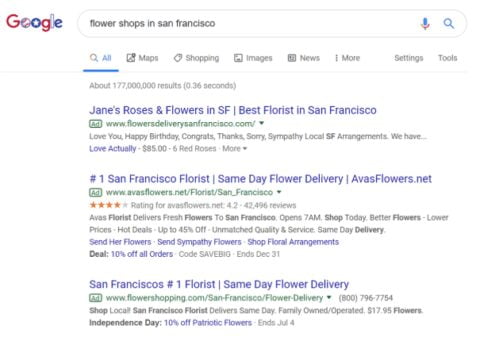Is your goal to sell products or services on your website? Then you need an email list. While there are multiple avenues to grow an email list, many pros are finding that SEM serves as an effective growth lever.
This post discusses 3 easy-to-use (and often neglected) SEM tactics any organization can use to increase high-quality email list signups.
1. Use long-tail keywords to build your list
You can use pay-per-click advertising (PPC) to grow your email list by sending traffic to an email capture page directly through your main ad. Depending on the competitiveness of your industry, and the keywords you target, PPC can quickly become an expensive endeavor. For the strict purposes of building your email list, focus on highly targeted, long-tail keywords.
For example, if a flower shop business wanted to build an email list in order to re-engage prospects during Valentine’s Day and Mother’s Day, they may want to target phrase match keywords such as, “Flower Shops in San Francisco” or “Flower Shops that Deliver.”
In an effort to be subscriber-centric, the flower shop business may offer a 20% off coupon on their website in exchange for providing a name and email address. It can also be effective to promote deals within your PPC ads–particularly if you have an offer for new subscribers.
2. Responsive Search Ads
Responsive Search Ads (RSAs) are Google’s newest, largest, and most flexible search ad format. Unlike traditional search ads, where you write your headlines and descriptions together to create 1 static ad text, RSAs allow you to write up to 15 different headlines and up to 4 different descriptions.
Collectively, those headlines and descriptions can be arranged in 43,680 different permutations. This means the ad testing possibilities are virtually endless!

Once your RSA is live within Google Ads, Google will automatically test different combinations of headlines and descriptions and learn which combinations perform best. Over the course of your campaign, RSAs will serve the best message to different searchers depending on the keyword they search for, their device, their past browsing behavior, and numerous other signals.
RSAs provide the opportunity to constantly test new ad variations and optimize for performance on their behalf. This will free marketers up to focus on other areas of their campaigns.
3. Audience Targeting
Google has made it easier for marketers to target users beyond keywords, device type, and location. Marketers who use audience data and optimize based on segmented audience types and lists will lead the market and have a huge advantage over their competition.

As marketers, we should familiarize ourselves with the various audience types in Google Ads, Bing Ads, DoubleClick, and other platforms that can be targeted.
Start testing and bid on audiences that are “Non-customers” or target an in-market audience that is visiting sites that align with your vertical.
Audience Targeting is important for any search campaign. Types of targeting examples might include:
- Remarketing Lists – e.g. visitors who spend over 2 minutes on-site without converting
- RLSAs – remarketing lists for search ads
- Customer Match – targeting a current email list with search ads
- Similar to all converters – focus on getting ads in front of the types of users who typically convert
- In-Market Audience – users whose search and browsing behavior indicates they may be “in-market” for a certain product or service
- Demographic Targeting – Gender, age, parental status, etc.
Targeting and optimizing marketing campaigns based on specific audience lists will enable you to achieve a better cost-per-lead (CPL) in growing your email lists. Check out 5 other strategies for lead generation that will help you grow your email list.
SEM and email list takeaways
You can grow your email list with these easy to implement tactics, but an email list is only valuable if you can convert those email recipients into customers. Make sure you create a compelling offer, build an effective subscriber experience, and manage your email campaigns based on qualitative metrics.
“Don’t be overly influenced by vanity metrics,” says Jill Guest, Sr. Engagement Marketing Manager at Twilio SendGrid. “Understanding open and click behavior of your recipients is great, if not critical, to a great email program, but clicks don’t matter if they don’t lead to long-term engagement or conversions. Focus instead on things like ROI, impact to churn, and customer advocacy.”
Planning and refining a successful email list growth strategy takes a thought-out plan, but if done properly, it can increase lead traffic, more appointments, brand awareness, and ultimately more sales!
For more tips on growing your email list, check out Twilio SendGrid’s How to Grow Your Email List Best Practice Guide.
